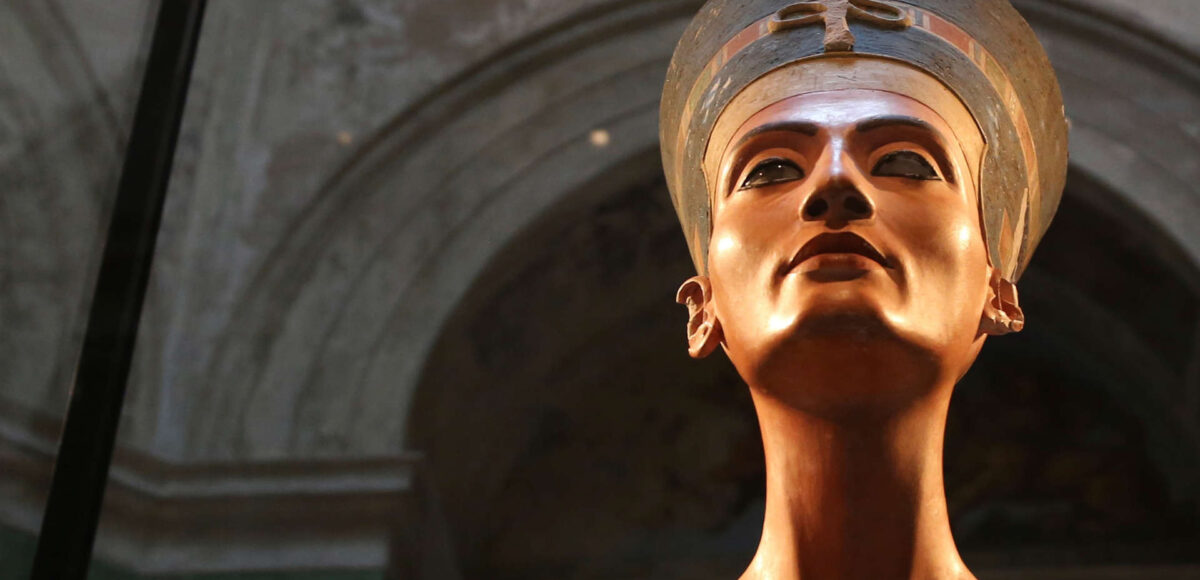Who knew behind all the glamor and beauty of one of Egypt’s most recognizable and well-preserved artifacts depicting ancient royalty–the Bust of Nefertiti–was a story full of lies, cheating, and theft?! Today, we’re going to take a deep dive into the displacement of the Bust of Nefertiti from Cairo to Berlin and how Egypt is attempting to reclaim what is rightfully theirs from the Neues Museum in one of the juiciest dramas of the century.
Bonds Broken
It began in 1907, when Ludwig Borchardt and the Deutsche Orient-Gesellschaft, or German Oriental Society, had begun excavations in Tell el-Amarna, capital of the kingdom of King Akhenaten. It was this campaign that yielded the discovery of Thutmose’s workshop. Thutmose was a sculptor who produced many works depicting pharaohs and their families. Most pertinent to the news of today, however, is his sculpture of Nefertiti, which Borchardt and the D.O.G. found in 1912. Part of the deal for this excavation was the “partage”. This was a practice standard of all excavations at the time between a government and foreign teams in which all finds from a campaign would be accessed by the home government of the artifacts to be equally divided among both parties. It is important to note that this system only works as intended given that all the artifacts found are actually reported; it’s essentially an honor system. What could possibly go wrong?

The Smuggling of the Century
Following the actual discovery of the bust, Germany instantly knew they had something huge. Borchardt reportedly went through extra measures to conceal the quality and importance of the artifact in order to make the Egyptian government overlook the bust. Some stories claim that the bust was poorly photographed and then placed in a box. Other sources say the bust was deliberately covered in mud. Some sources even say it was a mix of both. What we do know is that after she managed to go undetected during the division process, the Bust of Nefertiti was snuck away to the home of James Simon, a collector who funded the excavation. The artifact was then donated to the state and displayed in the Berlin Neues Museum in 1924. Note that this was 11 years after the other, less contentious finds of Amarna were installed in the museum. To us, this is a testament to just how aware the German government was of how bad this would be received. As you can (and Germany already did) imagine, this breach of trust didn’t go over well with the Egyptian government at all…

Egypt’s Request for Repatriation
Egypt’s demands for Nefertiti date all the way back to 1930, when German leader at the time, Adolf Hitler, refused to return the artifact. (Read all about that love affair in our other controversial inside scoop articles!) This fight for justice would continue being a point of contention between the two governments, all the way up until the next major development in 2007, when Germany realized claiming “fair-and-square” wasn’t going to cut it forever. In April of that year, Egypt’s director of the Supreme Council of Antiquities, Zahi Hawass, requested Nefertiti for a 3-month display in a Cairo museum set to open in 2011. Germany’s new rebuttal for these requests? Queen Nefertiti is much too fragile for transport. (This is excluding its many transports around Berlin, like the trip from Tiergarten to Museum Island, then to Dahlem, followed by Charlottenburg, and finally back to Museum Island, of course.) Hawass once again tried to appeal to the foundation in charge of the Neues Museum in 2009, but Germany’s excuse for not issuing a response was that his letter had not been authorized by the Prime Minister of Egypt.
Future Of Antiquity
To this day, German officials overseeing Nefertiti are not budging. We reached out for a comment from the president of the Prussian Cultural Heritage Foundation, Hermann Parzinger, who was very clear about his refusal to give up Nefertiti. “She is and remains the ambassador of Egypt in Berlin.” (Funny, considering ambassadors are typically WILLINGLY sent by the home country, but we digress.) The Department of Repatriated Objects at the Ministry of Antiquities are still at work on negotiations with Berlin about the return of Nefertiti while Hawass is reportedly petitioning other Egyptian officials to join him in the formal request for the return of the Bust of Nefertiti along with the Rosetta Stone and Zodiac ceiling from their own respective displacements in European museums. Until then, Nefertiti calls the Neues Museum in Berlin her home. It is there she stands thousands of miles from the Amarna Room of the Cairo Museum, where the other artifacts found beside her at Tell el-Amarna are displayed, including the statue of her own husband. If the tabloids have taught us anything, it’s that there’s nothing to fame if not a little bit of tragedy.
The Author:
McKenzie Broussard is a part of Colgate’s class of 2026 from Dallas, Texas. Growing up in a city surrounded by art and culture, McKenzie has always admired museums and the history behind the exhibits we sometimes tend to take at face value.
